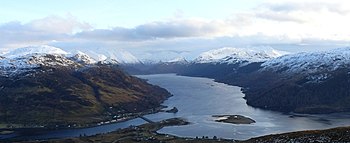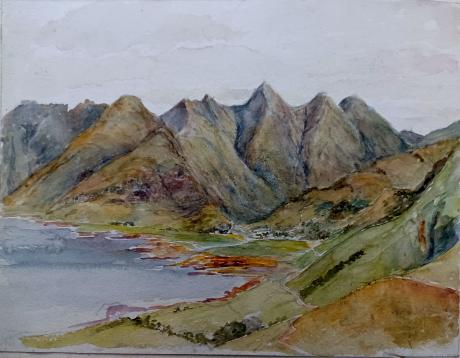inscribed "Loch Duich " and signed with initials "LWT"
Tom and Laura Taylor and thence by descent

Loch Duich (Scottish Gaelic: "Loch Dubhthaich") is a sea loch situated on the western coast of Scotland, in the Highlands.
In 1719, British forces burned many homesteads along the loch's shores in the month preceding the Battle of Glen Shiel.

Eilean Donan Castle stands at the meeting point of Loch Duich, Loch Long, and Loch Alsh.
A legend connected with Loch Duich states that three brothers who went fishing at the loch one night became enraptured by three seal-maidens who had thrown off their furs, assumed the likeness of humans, and danced in the moonlight on the sands. The brothers stole their furs, intending to claim the seal-maidens as their wives. The youngest brother, however, moved by the seal-girl's distress, returned her seal-skin. For his kindness, the girl's father allowed the youngest brother to visit the maiden every ninth night. As for the other two brothers, the middle brother lost his wife after the seal-maiden he had captured found her stolen fur, while the eldest brother burnt his wife's fur as a preventative measure, only to burn her accidentally in the process.
The infamous "McRae film" connected with the Loch Ness Monster was supposedly shot as a close-up of not only "Nessie" in its habitat of Loch Ness, but a second film allegedly shows a similar animal in Loch Duich. Both films are, according to most sources, held in a secret trust, and few people have seen either film. It is still a mystery as to whether the films exist at all, but are accepted by several Loch Ness researchers.
Loch Duich, along with the neighbouring sea lochs of Loch Long and Loch Alsh, was together designated as a Nature Conservation Marine Protected Area (NCMPA) in 2014. The designation is in place to protect the lochs' burrowed mud and their flame shell beds.
Laura Wilson Barker (6 March 1819 – 22 May 1905), was a composer, performer and artist, sometimes also referred to as Laura Barker, Laura W Taylor or "Mrs Tom Taylor".
She was born in Thirkleby, North Yorkshire, third daughter of a clergyman, the Rev. Thomas Barker. She studied privately with Cipriani Potter and became an accomplished pianist and violinist. As a young girl Barker performed with both Louis Spohr and Paganini. She began composing in the mid-1830s - her Seven Romances for voice and guitar were published in 1837. From around 1843 until 1855 she taught music at York School for the Blind. During this period some of her compositions - including a symphony in manuscript, on 19 April 1845 - were performed at York Choral Society concerts.
On 19 June 1855 she married the English dramatist, critic, biographer, public servant, and editor of Punch magazine Tom Taylor. Barker contributed music to at least one of her husband's plays, an overture and entr'acte to Joan of Arc (1871), and provided harmonisations as an appendix to his translation of Ballads and Songs of Brittany (1865).
Her other works include the cantata Enone (1850), the violin sonata A Country Walk (1860), theatre music for As You Like It, (April 1880), Songs of Youth (1884), string quartets, madrigals and solo songs. Her choral setting of Keats's A Prophecy, composed in 1850, was performed for the first time 49 years later at the Hovingham Festival in 1899. The composer was present.
Several of Barker's paintings hang at Smallhythe Place in Kent, Ellen Terry's house.
Barker lived with her husband and family at 84 Lavender Sweep, Battersea. There were two children: the artist John Wycliffe Taylor (1859–1925), and Laura Lucy Arnold Taylor (1863–1940). The Sunday musical soirees at the house attracted many well-known attendees, including Lewis Carroll, Charles Dickens, Henry Irving, Charles Reade, Alfred Tennyson, Ellen Terry and William Makepeace Thackeray.
Tom Taylor died suddenly at his home in 1880 at the age of 62. After his death, his widow retired to Porch House, Coleshill in Buckinghamshire, where she died on 22 May 1905, aged 86.

